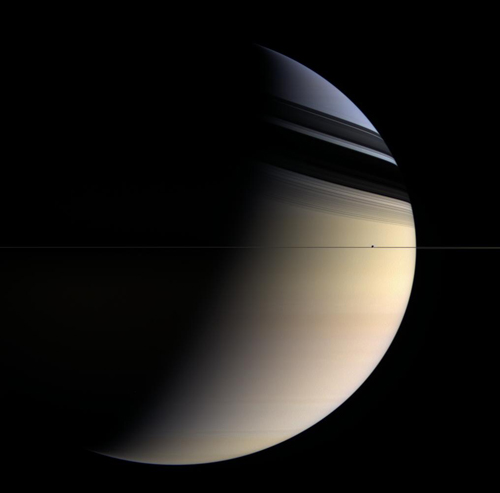Highlights of the Month
June - still a good month to observe Saturn.
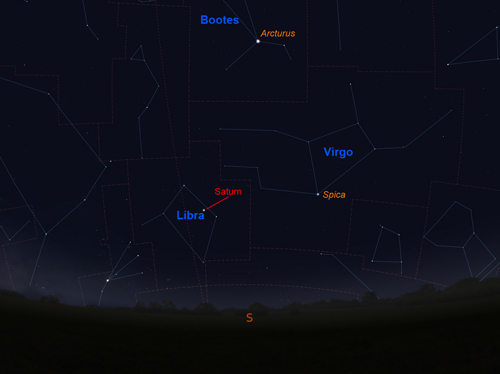
Saturn in the evening Sky
Saturn reached opposition on the 10th of May, so is now due south and highest in the sky soon after darkness falls.
To find it in the sky, follow the arc of the Plough's handle downwards to first find the orange star Arcturus and continue down to find the white, first magnitude star, Spica, in Virgo. Saturn, a little brighter than Spica, lies in Libra down to its lower left and will appear slighly yellow in colour.
Held steady, binoculars should enable you to see Saturn's brightest moon, Titan, at magnitude 8.2. A small telescope will show the rings with magnifications of x25 or more and one of 6-8 inches aperture with a magnification of ~x200 coupled with a night of good "seeing" (when the atmosphere is calm) will show Saturn and its beautiful ring system in its full glory.
As Saturn rotates quickly with a day of just 10 and a half hours, its equator bulges slightly and so it appears a little "squashed". Like Jupiter, it does show belts but their colours are muted in comparison.
The thing that makes Saturn stand out is, of course, its ring system. The two outermost rings, A and B, are separated by a gap called Cassini's Division which should be visible in a telescope of 4 or more inches aperture if seeing conditions are good. Lying within the B ring, but far less bright and difficult to spot is the C or Crepe Ring.
Due to the orientation of Saturn's rotation axis of 27 degrees with respect to the plane of the solar system, the orientation of the rings as seen by us changes as it orbits the Sun and twice each orbit they lie edge on to us and so can hardly be seen. This last happened in 2009 and they are now opening out, currently at an angle of 21 degrees to the line of sight. The rings will continue to open out until May 2017 and then narrow until March 2025 when they will appear edge-on again.
See more of Damian Peach's images: Damian Peaches Website"
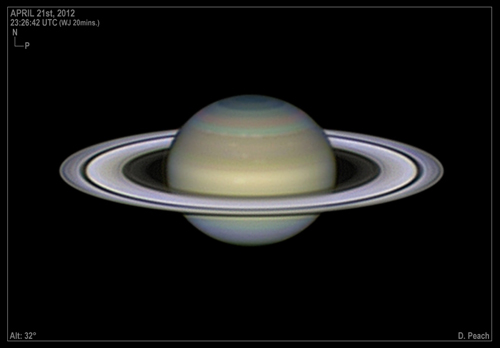
Saturn imaged in April 2012 by Damian Peach
June - Find the globular cluster in Hercules and spot the "Double-double" in Lyra
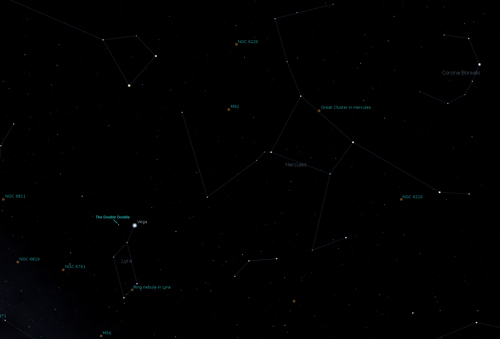
Use binoculars to find the globular cluster M13 in Hercules and the "Double-double" in Lyra
Image: Stellarium/IM
There are two very nice objects to spot with binoculars in the western sky well after dark this month. Two thirds of the way up the right hand side of the 4 stars that make up the "keystone" in the constellation Hercules is M13, the best globular cluster visible in the northern sky. The 15 minute exposure image on right was taken by the author using a 127 mm APO refractor and SBIG 8.3 megapixel CCD camera.
Just to the left of the bright star Vega in Lyra is the multiple star system Epsilon Lyrae often called the double-double. With binoculars a binary star is seen but, when observed with a telescope, each of these two stars is revealed to be a double star - hence the name!
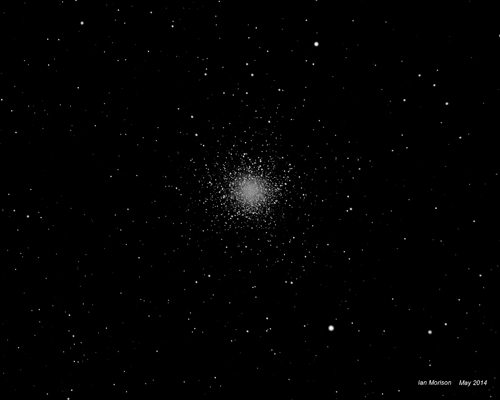
M13 imaged by Ian Morison in May 2014
Late June: A very good time to spot Noctilucent Clouds!
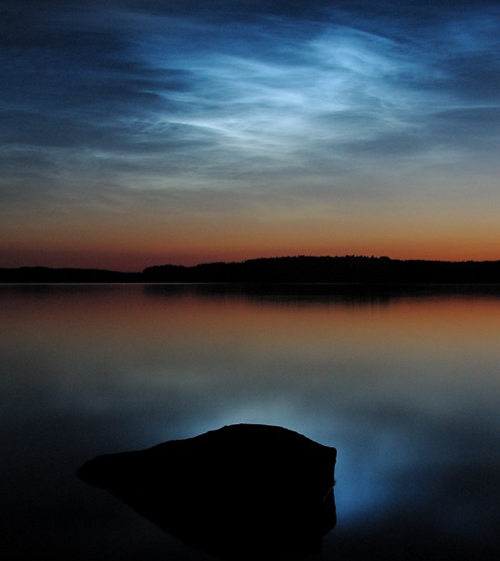
June: the chance to spot Noctilucent Clouds
Image: Wikipedia Commons
Noctilucent clouds, also known as polar mesospheric clouds, are most commonly seen in the deep twilight towards the north from our latitude. They are the highest clouds in the atmosphere at heights of around 80 km or 50 miles. Normally too faint to be seen, they are visible when illuminated by sunlight from below the northern horizon whilst the lower parts of the atmosphere are in shadow. They are not fully understood and are increaing in frequencey, brightness and extent; some think that this might be due to climate change! So on a clear dark night as light is draining from the north western sky long after sunset take a look towards the north and you might just spot them!
June 2nd to 4th - one hour after sunset: Jupiter and Mercury in the western sky.
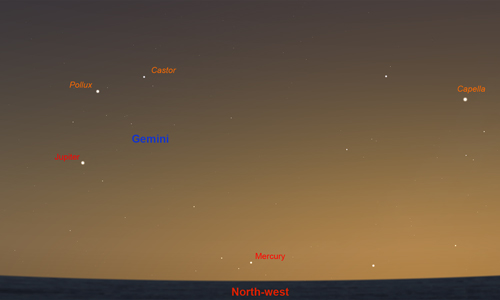
Jupiter and Mercury
Image: Stellarium/IM
Looking towards the West-Northwest after sunset you should be able to spot Jupiter lying below Pollux in Gemini. Given a very low horizon you you may also see the far fainter planet Mercury well below and a little to the right of Castor.
June 7th - one hour after sunset: Mars and a gibbous Moon.
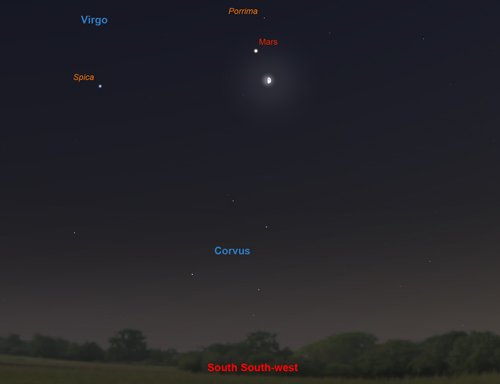
Mars and the Moon
Image: Stellarium/IM
Looking towards the South-west as darkness falls, Mars will be seen just under 3 degrees above and a little to the left of a waxing gibbous Moon.
June 10th - after sunset: Saturn and a gibbous Moon.
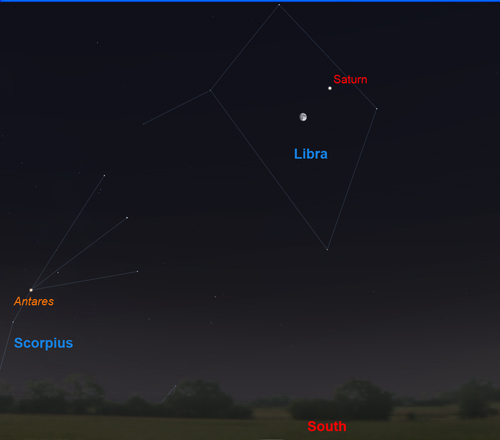
Saturn near a gibbous Moon.
Image: Stellarium/IM
Looking South South-east after sunset Saturn will be seen just under 2 degrees up and to the right of the Moon, three days before full.
June 24th - before dawn: Venus and a thin crescent Moon.
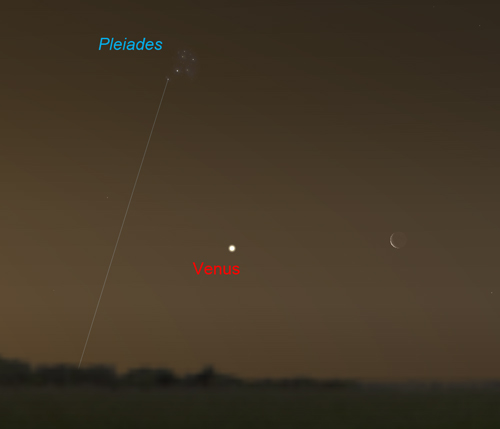
Venus and a thin crescent Moon
Image: Stellarium/IM
Looking East before dawn, Venus, lying between the Pleiades and Hyades clusters in Taurus, will be seen ~2.5 degrees to the left of a thin crescent Moon. This would make a nice wide field image should it be clear.
June 6th and 7th: The Alpine Valley
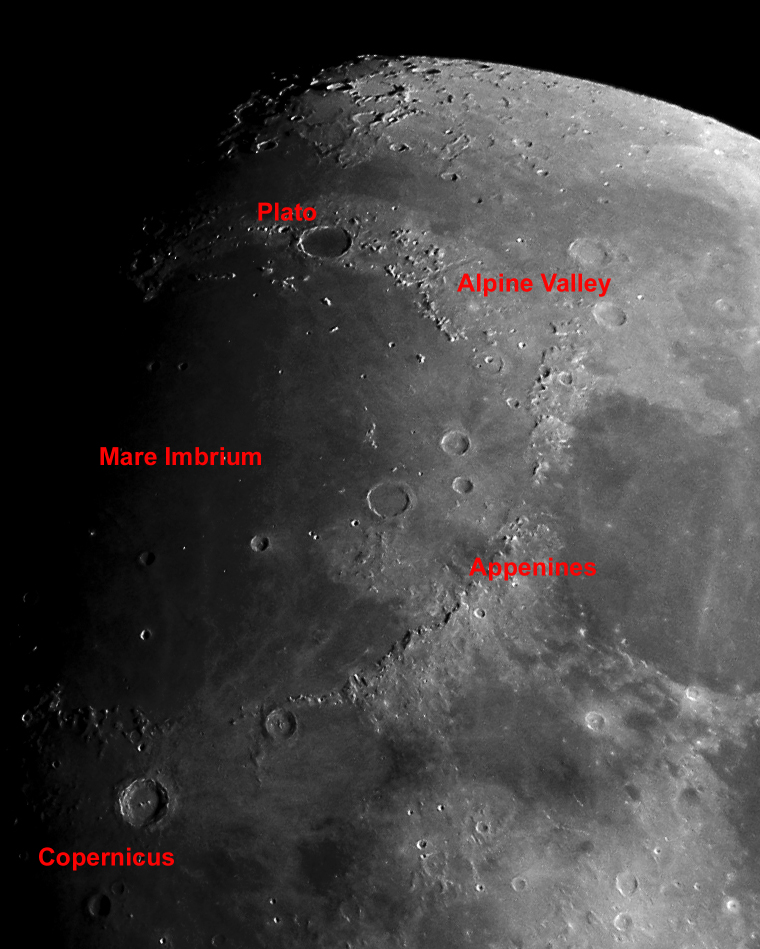
Alpine Valley region
An interesting valley on the Moon: The Alpine Valley
These are two good nights to observe an interesting feature on the Moon if you have a small telescope. Close to the limb (on the 6th) is the Appenine mountain chain that marks the edge of Mare Imbrium. Towards the upper end you should see the cleft across them called the Alpine valley. It is about 7 miles wide and 79 miles long. As shown in the image a thin rill runs along its length which is quite a challenge to observe. Over the next two nights the dark crater Plato and the young crater Copernicus will come into view. This is a very interesting region of the Moon!

The Alpine valley and the crater Plato
A Messier Object imaged with the Faulkes Telescope: Messier 27 - The Dumbell Nebula
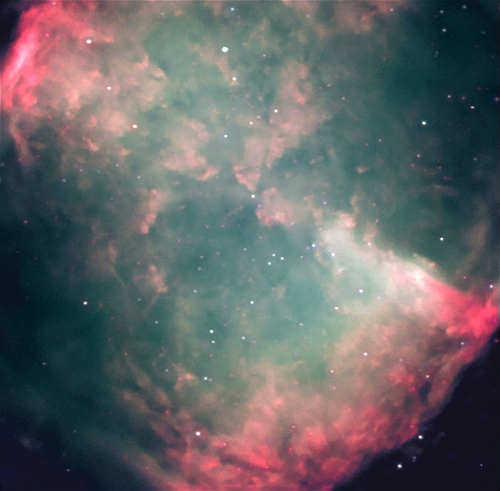
The Dumbell Nebula
Image:Nik Szymanik
Faulkes Telescope North.
The Dumbell Nebula, imaged by Nik Szymanek.
This image was taken using the Faulkes Telescope North by Nik Szymanek - one of the UK's leading astro-photograpers. M27 is a planetary nebula, the result of a "nova" expolsion at the end of the life of a star like our Sun. The core at the centre of the star collapes under gravity until it is about the size of the Earth when "electron degeneracy pressure", resulting from the fact that electrons do not like being squashed too close together, prevents further collapse. This is called a "white dwarf". As the dying ember of a nuclear fusion reactor, they are exceedingly hot, but will gradually cool over time. The outer parts of the star are expelled at high speed into space resulting in the (in this case) spherical nebula surrounding the white dwarf. The field of the view of the CCD array on the Faulkes Telesocpe is a little too small to encompass the whole nebula. Once, with a 16 inch telescope under perfect conditions, I visually observed M27 and its central part appeared a vivid iridescent green - the only time I have ever seen colour in a deep sky object!
Learn more about the Faulkes Telescopes and how schools can use them: Faulkes Telescope"
Observe the International Space Station

The International Space Station and Jules Verne passing behind the Lovell Telescope on April 1st 2008.
Image by Andrew Greenwood
Use the link below to find when the space station will be visible in the next few days. In general, the space station can be seen either in the hour or so before dawn or the hour or so after sunset - this is because it is dark and yet the Sun is not too far below the horizon so that it can light up the space station. As the orbit only just gets up the the latitude of the UK it will usually be seen to the south, and is only visible for a minute or so at each sighting. Note that as it is in low-earth orbit the sighting details vary quite considerably across the UK. The NASA website linked to below gives details for several cities in the UK. (Across the world too for foreign visitors to this web page.)
Note: I observed the ISS three times recently and was amazed as to how bright it has become.
Find details of sighting possibilities from your location from: Location Index
See where the space station is now: Current Position
The Moon
 The Moon at 3rd Quarter. Image, by Ian Morison, taken with a 150mm Maksutov-Newtonian and Canon G7.
The Moon at 3rd Quarter. Image, by Ian Morison, taken with a 150mm Maksutov-Newtonian and Canon G7.
Just below the crator Plato seen near the top of the image is the mountain "Mons Piton". It casts a long shadow across the maria from which one can calculate its height - about 6800ft or 2250m.
| new moon |
first quarter |
full moon |
last quarter |
`
| June 27th |
June 5th |
June 13th |
June 19th |
Some Lunar Images by Ian Morison, Jodrell Bank Observatory: Lunar Images
A World Record Lunar Image
 The 9 day old Moon.
The 9 day old Moon.
To mark International Year of Astronomy, a team of British astronomers have made the largest lunar image in history and gained a place in the Guinness Book of Records! The whole image comprises 87.4 megapixels with a Moon diameter of 9550 pixels. This allows details as small as 1km across to be discerned! The superb quality of the image is shown by the detail below of Plato and the Alpine Valley. Craterlets are seen on the floor of Plato and the rille along the centre of the Alpine valley is clearly visible. The image quality is staggering! The team of Damian Peach, Pete lawrence, Dave Tyler, Bruce Kingsley, Nick Smith, Nick Howes, Trevor Little, David Mason, Mark and Lee Irvine with technical support from Ninian Boyle captured the video sequences from which 288 individual mozaic panes were produced. These were then stitched together to form the lunar image.
 Plato and the Alpine Valley.
Plato and the Alpine Valley.
Please follow the link to the Lunar World Record website and it would be really great if you could donate to Sir Patrick Moore's chosen charity to either download a full resolution image or purchase a print.
The Planets

A montage of the Solar System. JPL / Nasa
Jupiter

A Cassini image of Jupiter . Nasa
Jupiter. As June begins, Jupiter sets nearly 3 hours after sunset. It is, however, now well past its best and fading from -1.9 to -1.8 during the month whilst its angular diameter shrinks from 33 to 32 arc seconds as it moves towards superior conjunction with the Sun on July 24th. By month's end it will be low above the horizon after sunset forming an almost straight line to the left of Castor and Pollux in the constellation of Gemini. With a small telescope you can observe the 4 Gallilean moons as they weave there way around it but, due to the low elevation, details on the surface such as the equatorial bands and the Great Red Spot will be harder to see than in previous months.
Saturn

The planet Saturn. Cassini - Nasa
Saturn came to opposition on May 10th and as June begins is high in the south as darkness begin lying in Libra,midway between Spica and Antares. It is shining with a magnitude of +0.2.as June begins, falling to +0.4 by months end. Its fully illuminated disk has a diameter of ~18 arc seconds. Saturn began its retrograde motion across the sky on March 6th is now moving slowly westwards in Libra towards the double star system Alpha Librae and ends the month just 2.5 degrees above and a little to the left.. The good news is that the rings (with a diameter of ~40 arc seconds) have now opened to around 21 degrees from the line of sight so presenting a magnificant view. With a small telescope one should be able to spot the Cassini Division that lies between the A and B rings when seeing conditions are good. Sadly for those of us in the northern hemisphere, Saturn is now lying in the more southerly part of the ecliptic so, even when due south around midnght (UT) does not get that high in the sky. Even worse, this will not improve for many years to come.
See highlights above.
Mercury

Messenger image of Mercury Nasa
Mercury. Given a low horizon in the west-northwest it should be possible to spot Mercury about 45 minutes after sunset at the very start of June but, fading rapidly (from +1.2 to +3.4 by the 11th), it will soon be lost to view as it moves towards inferior conjunction (lying between the Earth and Sun)on June 19th.
See highlight above.
Mars

A Hubble Space Telescope image of Mars.
Jim Bell et al. AURA / STScI / Nasa
Mars. Following its opposition in April, Mars is now receding rapidly and so will dim from magnitude -0.5 to 0 during the month. As it does so, its angular size will shrink from 11.8 down to 9.5 arc seconds so its best to observe it early in the month if the weather allows. Mars halted its retrograde motion westwards in the sky on May 21st so is now moving eastwards through Virgo. It starts June just 2.5 degrees below Porrima, Gamma Virginis,and ends the month 3.5 degrees to the right of Spics, Alpha Virginis. It will be highest in the sky as darkness falls and gives us a last chance this apparition to observe features on the surface.
See highlight above.
Venus

Venus showing some cloud structure
Venus, shining at magnitude ~-3.9 during the month,is moving rapidly westwards across the lower part of Aries and into Taurus where it passes between the Pleiades and Hyades clusters on the 28th and will be seen low above the eastern horizon half an hour before sunrise. It ends the month 3.5 degrees above Aldebaran. Its disk, now showing a full gibbous phase as it moves beyond the Sun drops in angular size from 14 to 12 arc seconds but, at the same time the percentage of the disk which is illuminated increases from 77 to 85%. As a result the effective area reflecting the sun's light stays almost constant so there is only a drop of 0.1 (from -4 to -3.9) magnitudes in brightness.
See highlight above.

Radar image showing surface features
Find more planetary images and details about the Solar System: The Solar System
The late evening June Sky
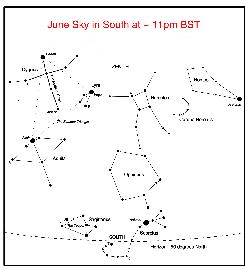
The June Sky in the south - late evening.
This map shows the constellations seen towards the south at about 11pm BST in mid June. High over head towards the north (not shown on the chart) lies Ursa Major. As one moves southwards one first crosses the constellation Hercules with its magnificent globular cluster, M13, and then across the large but not prominent constellation Ophiucus until, low above the southern horizon lie Sagittarius and Scorpio. To the right of Hercules lie the arc of stars making up Corona Borealis and then Bootes with its bright star Arcturus. Rising in the east is the beautiful region of the Milky Way containing both Cygnus and Lyra. Below is Aquilla. The three bright stars Deneb (in Cygnus), Vega (in Lyra) and Altair (in Aquila) make up the "Summer Triangle".
The constellation Ursa Major
 Ursa Major
Ursa Major
The stars of the Plough, shown linked by the thicker lines in the chart above, form one of the most recognised star patterns in the sky. Also called the Big Dipper, after the soup ladles used by farmer's wives in America to serve soup to the farm workers at lunchtime, it forms part of the Great Bear constellation - not quite so easy to make out! The stars Merak and Dubhe form the pointers which will lead you to the Pole Star, and hence find North. The stars Alcor and Mizar form a naked eye double which repays observation in a small telescope as Mizar is then shown to be an easily resolved double star. A fainter reddish star forms a triangle with Alcor and Mizar.
Ursa Major contains many interesting "deep sky" objects. The brightest, listed in Messier's Catalogue, are shown on the chart, but there are many fainter galaxies in the region too. In the upper right of the constellation are a pair of interacting galaxies M81 and M82 shown in the image below. M82 is undergoing a major burst of star formation and hence called a "starburst galaxy". They can be seen together using a low power eyepiece on a small telescope.
 M81 and M82
M81 and M82
Another, and very beautiful, galaxy is M101 which looks rather like a pinwheel firework, hence its other name the Pinwheel Galaxy. It was discovered in1781 and was a late entry to Messier's calalogue of nebulous objects. It is a type Sc spiral galaxy seen face on which is at a distance of about 24 million light years. Type Sc galaxies have a relativly small nucleus and open spiral arms. With an overall diameter of 170,000 light it is one of the largest spirals known (the Milky Way has a diameter of ~ 130,000 light years).
 M101 - The Ursa Major Pinwheel Galaxy
M101 - The Ursa Major Pinwheel Galaxy
Though just outside the constellation boundary, M51 lies close to Alkaid, the leftmost star of the Plough. Also called the Whirlpool Galaxy it is being deformed by the passage of the smaller galaxy on the left. This is now gravitationally captured by M51 and the two will eventually merge. M51 lies at a distance of about 37 million light years and was the first galaxy in which spiral arms were seen. It was discovered by Charles Messier in 1773 and the spiral structure was observed by Lord Rosse in 1845 using the 72" reflector at Birr Castle in Ireland - for many years the largest telescope in the world.
 M51 - The Whirlpool Galaxy
M51 - The Whirlpool Galaxy
Lying close to Merak is the planetary nebula M97 which is usually called the Owl Nebula due to its resemblance to an owl's face with two large eyes. It was first called this by Lord Rosse who drew it in 1848 - as shown in the image below right. Planetary nebulae ar the remnants of stars similar in size to our Sun. When all possible nuclear fusion processes are complete, the central core collpses down into a "white dwarf" star and the the outer parts of the star are blown off to form the surrounding nebula.

 M97 - The Owl Planetary Nebula Lord Rosse's 1848 drawing of the Owl Nebula
M97 - The Owl Planetary Nebula Lord Rosse's 1848 drawing of the Owl Nebula
The constellation Hercules
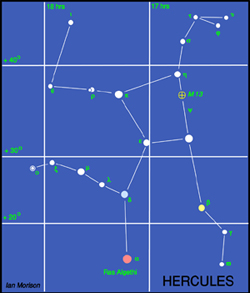 Hercules
Hercules
Between the constellation Bootes and the bright star Vega in Lyra lies the constellation Hercules.The Red Giant star Alpha Herculis or Ras Algethi, its arabic name, is one of the largest stars known, with a diameter of around 500 times that of our Sun. In common with most giant stars it varies its size, changing in brightness as it does so from 3rd to 4th magnitude. Lying along one side of the "keystone" lies one of the wonders of the skies, the great globular cluster, M13. Just visible to the unaided eye on a dark clear night, it is easily seen through binoculars as a small ball of cotten wool about 1/3 the diameter of the full Moon. The brightness increases towards the centre where the concentration of stars is greatest. It is a most beautiful sight in a small telescope. It contains around 300,000 stars in a region of space 100 light years across, and is the brightest globular cluster that can be seen in the northern hemisphere.
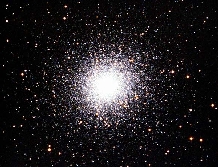 The Globular Cluster M13 in Hercules. Image by Yuugi Kitahara
The Globular Cluster M13 in Hercules. Image by Yuugi Kitahara
The constellation Virgo
 Virgo
Virgo
Virgo, in the south-east after sunset this month, is not one of the most prominent constellations, containing only one bright star, Spica, but is one of the largest and is very rewarding for those with "rich field" telescopes capable of seeing the many galaxies that lie within its boundaries. Spica is, in fact, an exceedingly close double star with the two B type stars orbiting each other every 4 days. Their total luminosity is 2000 times that of our Sun. In the upper right hand quadrant of Virgo lies the centre of the Virgo Cluster of galaxies. There are 13 galaxies in the Messier catalogue in this region, all of which can be seen with a small telescope. The brightest is the giant elliptical galaxy, M87, with a jet extending from its centre where there is almost certainly a massive black hole into which dust and gas are falling. This releases great amounts of energy which powers particles to reach speeds close to the speed of light forming the jet we see. M87 is also called VIRGO A as it is a very strong radio source.

 The Giant Elliptical Galaxy M87 HST image showing the jet
The Giant Elliptical Galaxy M87 HST image showing the jet
Below Porrima and to the right of Spica lies M104, an 8th magnitude spiral galaxy about 30 million light years away from us. Its spiral arms are edge on to us so in a small telescope it appears as an elliptical galaxy. It is also known as the Sombrero Galaxy as it looks like a wide brimmed hat in long exposure photographs.
 M104 - The Sombrero Galaxy
M104 - The Sombrero Galaxy
The constellations Lyra and Cygnus

Lyra and Cygnus
This month the constellations Lyra and Cygnus are rising in the East as darkness falls with their bright stars Vega, in Lyra, and Deneb, in Cygnus, making up the "summer triangle" of bright stars with Altair in the constellation Aquila below. (see sky chart above)
Lyra
Lyra is dominated by its brightest star Vega, the fifth brightest star in the sky. It is a blue-white star having a magnitude of 0.03, and lies 26 light years away. It weighs three times more than the Sun and is about 50 times brighter. It is thus burning up its nuclear fuel at a greater rate than the Sun and so will shine for a correspondingly shorter time. Vega is much younger than the Sun, perhaps only a few hundred million years old, and is surrounded by a cold,dark disc of dust in which an embryonic solar system is being formed!
There is a lovely double star called Epsilon Lyrae up and to the left of Vega. A pair of binoculars will show them up easily - you might even see them both with your unaided eye. In fact a telescope, provided the atmosphere is calm, shows that each of the two stars that you can see is a double star as well so it is called the double double!

Epsilon Lyra - The Double Double
Between Beta and Gamma Lyra lies a beautiful object called the Ring Nebula. It is the 57th object in the Messier Catalogue and so is also called M57. Such objects are called planetary nebulae as in a telescope they show a disc, rather like a planet. But in fact they are the remnants of stars, similar to our Sun, that have come to the end of their life and have blown off a shell of dust and gas around them. The Ring Nebula looks like a greenish smoke ring in a small telescope, but is not as impressive as it is shown in photographs in which you can also see the faint central "white dwarf" star which is the core of the original star which has collapsed down to about the size of the Earth. Still very hot this shines with a blue-white colour, but is cooling down and will eventually become dark and invisible - a "black dwarf"! Do click on the image below to see the large version - its wonderful!

M57 - the Ring Nebula
Image: Hubble Space telescope
M56 is an 8th magnitude Globular Cluster visible in binoculars roughly half way between Alberio (the head of the Swan) and Gamma Lyrae. It is 33,000 light years away and has a diameter of about 60 light years. It was first seen by Charles Messier in 1779 and became the 56th entry into his catalogue.

M56 - Globular Cluster
Cygnus
Cygnus, the Swan, is sometimes called the "Northern Cross" as it has a distinctive cross shape, but we normally think of it as a flying Swan. Deneb,the arabic word for "tail", is a 1.3 magnitude star which marks the tail of the swan. It is nearly 2000 light years away and appears so bright only because it gives out around 80,000 times as much light as our Sun. In fact if Deneb where as close as the brightest star in the northern sky, Sirius, it would appear as brilliant as the half moon and the sky would never be really dark when it was above the horizon!
The star, Albireo, which marks the head of the Swan is much fainter, but a beautiful sight in a small telescope. This shows that Albireo is made of two stars, amber and blue-green, which provide a wonderful colour contrast. With magnitudes 3.1 and 5.1 they are regarded as the most beautiful double star that can be seen in the sky.

Alberio: Diagram showing the colours and relative brightnesses
Cygnus lies along the line of the Milky Way, the disk of our own Galaxy, and provides a wealth of stars and clusters to observe. Just to the left of the line joining Deneb and Sadr, the star at the centre of the outstretched wings, you may, under very clear dark skys, see a region which is darker than the surroundings. This is called the Cygnus Rift and is caused by the obscuration of light from distant stars by a lane of dust in our local spiral arm. the dust comes from elements such as carbon which have been built up in stars and ejected into space in explosions that give rise to objects such as the planetary nebula M57 described above.
Deneb,the arabic word for "tail", is a 1.3 magnitude star which marks the tail of the swan. It is nearly 2000 light years away and appears so bright only because it gives out around 80,000 times as much light as our Sun. In fact if Deneb where as close as the brightest star in the northern sky, Sirius, it would appear as brilliant as the half moon and the sky would never be really dark when it was above the horizon!
There is a beautiful region of nebulosity up and to the left of Deneb which is visible with binoculars in a very dark and clear sky. Photographs show an outline that looks like North America - hence its name the North America Nebula. Just to its right is a less bright region that looks like a Pelican, with a long beak and dark eye, so not surprisingly this is called the Pelican Nebula. The photograph below shows them well.

The North American Nebula
Brocchi's Cluster An easy object to spot with binoculars in Gygnus is "Brocchi's Cluster", often called "The Coathanger",although it appears upside down in the sky! Follow down the neck of the swan to the star Alberio, then sweep down and to its lower left. You should easily spot it against the dark dust lane behind.

Brocchi's Cluster - The Coathanger
